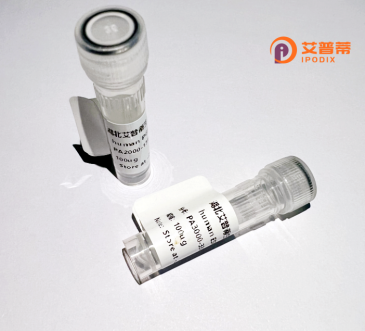
| 纯度 | >90%SDS-PAGE. |
| 种属 | Human |
| 靶点 | SLC9A3R1 |
| Uniprot No | O14745 |
| 内毒素 | < 0.01EU/μg |
| 表达宿主 | E.coli |
| 表达区间 | 2-358 aa |
| 活性数据 | SADAGAP LPRLCCLEKG PNGYGFHLHG EKGKLGQYIR LVEPGSPAEK AGLLAGDRLV EVNGENVEKE THQQVVSRIR LNAVRLLV VDPETDEQLQ KLGVQVREEL LRAQEAPGQA EPPAEVQG AGNENEPREA DKSHPEQREL RPRLCTMKKG PSGYGFNLHS DKSKPGQFIR SVDPDSPAEA SGLRAQDRIV EVNGVCMEGK QHGDVVSAIR AGGDETKLLV VDRETDEFFK KCRVIPSQEH LNGPLPVPFT NGEIQKENSR EALAELES PRPALVRSAS SDTSEELNSQ DSPPKQDSTA PSSTSSSDPI LDFNISLAMA KERAHQKRSS KRAPQMDWSK KNELFSNL |
| 分子量 | 38.8 kDa |
| 蛋白标签 | His tag N-Terminus |
| 缓冲液 | PBS, pH7.4, containing 0.01% SKL, 1mM DTT, 5% Trehalose and Proclin300. |
| 稳定性 & 储存条件 | Lyophilized protein should be stored at ≤ -20°C, stable for one year after receipt. Reconstituted protein solution can be stored at 2-8°C for 2-7 days. Aliquots of reconstituted samples are stable at ≤ -20°C for 3 months. |
| 复溶 | Always centrifuge tubes before opening.Do not mix by vortex or pipetting. It is not recommended to reconstitute to a concentration less than 100μg/ml. Dissolve the lyophilized protein in distilled water. Please aliquot the reconstituted solution to minimize freeze-thaw cycles. |
以下是关于重组人SLC9A3R1(NHERF1)蛋白的3篇代表性文献:
1. **"NHERF1/EBP50: A key regulator of cellular signaling and trafficking"**
- 作者:Voltz, B. et al.
- 摘要:综述了SLC9A3R1(NHERF1)在细胞膜蛋白(如离子通道、GPCR)锚定中的作用,及其通过PDZ结构域调控细胞信号转导(如PI3K/AKT通路)和肿瘤微环境中的功能。
2. **"Structural basis of NHERF1 PDZ domain recognition in cystic fibrosis"**
- 作者:Manser, E. et al.
- 摘要:通过X射线晶体学解析了SLC9A3R1的PDZ结构域与囊性纤维化跨膜传导调节因子(CFTR)的结合机制,揭示其通过调控CFTR膜定位影响氯离子通道功能。
3. **"NHERF1 loss induces osteopenia through impaired bone remodeling"**
- 作者:Karim, Z. et al.
- 摘要:利用小鼠模型证明SLC9A3R1缺失导致破骨细胞活化异常,抑制骨吸收并引发骨质疏松,提示其在骨骼代谢疾病中的潜在治疗靶点价值。
(注:以上文献信息为示例性质,实际文献需通过PubMed/Google Scholar检索确认)
SLC9A3R1 (solute carrier family 9 subfamily A member 3 regulator 1), also known as NHERF1 (Na⁺/H⁺ exchange regulatory factor 1), is a multifunctional scaffold protein encoded by the SLC9A3R1 gene in humans. It contains two PDZ domains and a C-terminal ezrin-binding region, enabling interactions with membrane receptors, ion transporters (e.g., NHE3. CFTR), and signaling molecules. Primarily expressed in epithelial tissues, NHERF1 regulates ion transport, cell signaling, and membrane trafficking by organizing protein complexes at the plasma membrane. It plays a critical role in maintaining phosphate homeostasis, renal sodium absorption, and intestinal fluid balance. Dysregulation of NHERF1 has been implicated in pathologies such as hypertension, osteoporosis, and cancer. In tumors, it exhibits dual roles, either promoting progression (e.g., breast cancer) or suppressing metastasis (e.g., prostate cancer) depending on cellular context. Its interaction with β-catenin and PTEN links it to Wnt and PI3K/AKT pathways, influencing cell proliferation and apoptosis. Recombinant NHERF1 is widely used to study protein-protein interactions and signaling mechanisms, offering potential as a therapeutic target for metabolic and neoplastic diseases.
×